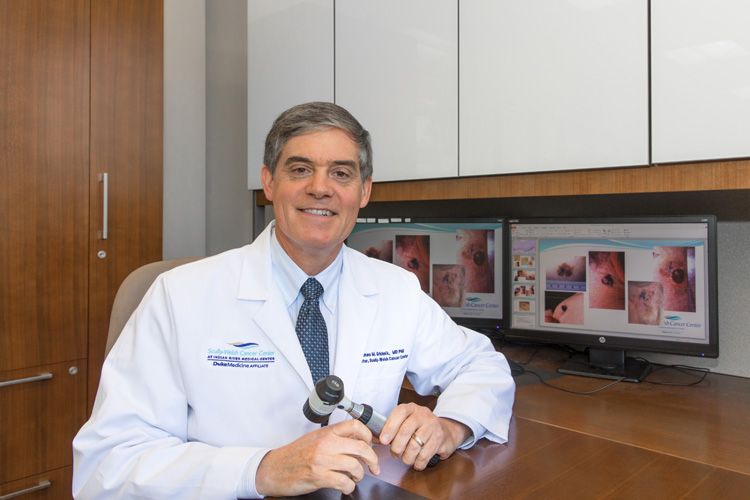
The latest community health needs assessment survey conducted in Indian River County found alarmingly high rates of – and a high level of concern about – skin cancer.
In response to a question in the survey that asked whether respondents in the county had ever had skin cancer, “21.3 percent suggested they had had skin cancer whereas in the entire state of Florida [that figure was] only 9.1 percent,” says Scully-Welsh Cancer Center Director Dr. James Grichnik.
Grichnik is still working to determine what Scully-Welsh can do to reduce that shocking incidence of skin cancer, but he said better skin-health education is the best first step.
“The unfortunate truth,” he says, “is that that exposure to ultraviolet light causes a lot of mutations in the skin and ultimately results in skin cancer. We have an older demographic here – it’s something on the order of, I think, maybe 70 percent or more who are over the age 50.”
And since developing skin cancer is largely a cumulative thing, older people, who have had more exposure to ultraviolet light than younger people, are more likely to contract the disease.
“We are being blasted by ultraviolet light,” Grichnik says. “I think people don’t really appreciate how much damage we already have stored in our skin. Yes, it’s cumulative. Hugely cumulative.”
That said, it’s hard to change social norms and people’s habitual behavior.
For decades having a “healthy tan” wasn’t considered the oxymoron that it actually is. Being tanned was seen as highly desirable, vaguely synonymous with being fit and happy.
Today, many doctors recommend checking your own skin once a month using a full-length mirror along with a hand-held mirror to look at areas that are hard to see, like your back or neck, yet most of those physicians will admit getting their patients to comply with such a routine is not easy.
It’s here where Grichnik offers a novel proposal: educating a range of personal care professionals to help spot skin cancers that might otherwise go undetected until it is too late. Given the proper training, he says, hairdressers, dentists and masseuses and others might well help detect skin cancers at their earliest and most easily treatable stages.
“Hairdressers, he says, “can play an important role in identifying a melanoma that might be on the scalp. Dentists might be able to identify melanoma that might occur in the oral space.
“A masseuse might be able to identify a region of concern on the back. Our interest would be in educating anybody that has the ability to look at the skin surface.”
This Harvard-educated physician also reemphasizes basic safety precautions we’ve heard for years, advising people to avoid being outdoors (or at least in direct sunlight) at midday, use zinc or titanium-based sun blockers, and wear loose-fitting long-sleeved clothing when outdoors – simple steps that can help reduce the risk of skin cancer.
Skin cancer “begins in the epidermis, which is made up of three kinds of cells,” according to the National Cancer Institute. “Squamous cells, which are thin, flat cells that form the top layer of the epidermis. Beneath them are basal cells or the round cells under the squamous cells. Below that layer are melanocytes; the cells that make melanin and are found in the lower part of the epidermis. Melanin is the pigment that gives skin its natural color and when exposed to the sun or artificial light, melanocytes make more pigment and cause the skin to darken.”
And while “melanoma” is the type of skin cancer most people know and fear, the most common types of skin cancer actually are basal cell carcinoma and squamous cell carcinomas.
“Probably more people die from metastatic squamous cell carcinoma” than from the better-known melanoma, Grichnik says.
That said, when caught and treated early, all forms of skin cancer are almost always curable.
Dr. James Grichnik is the director of the Scully-Welsh Cancer Center at 3555 10th Court behind the Cleveland Clinic Indian River Hospital. The phone number is 772-226-4800.
Main image: Dr James Grichnik, by Denise Ritchie, Vero Beach 32963




Comments